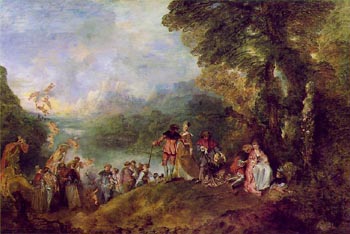| Search Art Prints | ||||||||||||||||||||
| Search Artists | ||||||||||||||||||||

|
||||||||||||||||||||
|
|
|||||||||||||||||||

The Embarkation for Cythera

|
The Embarkation for Cythera
French Rococo artist Jean-Antoine Watteau painted ‘The Embarkation for Cythera’ and submitted it to the Royal Academy of Painting and Sculpture as his reception piece in 1717. A master at depth perception, Watteau created a sense of great expanse between hazy, distant forestry and lush, foreground foliage, an effect that entices the viewer to enter his composition.
‘The Embarkation for Cythera’ depicts what is known as a "fête gallant", an elaborate celebration typically enjoyed by France’s aristocracy during the reign of Louis XV. The elite would venture to the countryside in order to indulge in flirtatious behavior and party in an atmosphere of lust and luxury.
Analysis
The painting’s pastoral setting possesses an essence of paradise, an atmosphere of fantasy rather than stark realism. The use of wispy, soft brush strokes produces a dream-like scene. The colors are agreeable, albeit not vibrant. It is difficult to determine whether it is spring or fall, dawn or dusk. The small-scale figures are rather inconspicuous, and less impressive than the magnificent, lush trees surrounding them; nevertheless, the implied interactions between the couples spark the viewer’s imagination and produce the fantastical tale that is part of ‘The Embarkation for Cythera’.
The statue of Venus, goddess of love, and the many cupids flying around the couples, pushing them closer together, produce erotic overtones, highlighting the sexual nature of the event. Starting from right to left, there are three prominent pairs of lovers: two individuals next to the statue are engaged in what seems to be a passionate tryst, and another couple rises to follow a third pair down the hill. One woman glances back fondly at Venus, suggesting a feeling of sorrow in parting. At the foot of the hill, several more happy couples are preparing to board the golden gondola at the left.
In 1718 or 1719, Watteau painted a second, similar version of ‘The Embarkation for Cythera’; it is located in the Charlottenburg Palace in Berlin, Germany. The original painting is housed in the Louvre in Paris, France.











